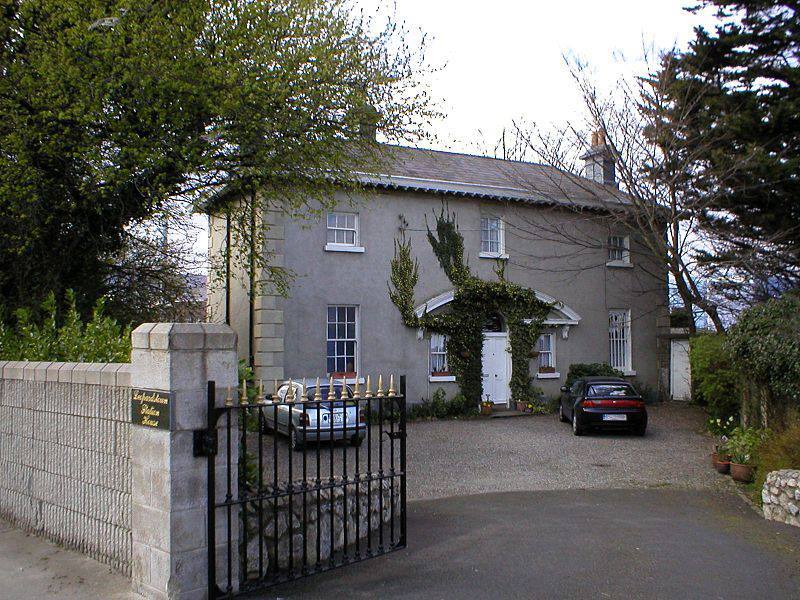Stillorgan Railway Station & Station House
NAME Stillorgan Station Crossing House/Leopardstown Station House
AREA LOCATION Brewery Road beside the entrance to The Reservoir.
MAP LOCATION OSI map of 1898-1913 place it in the townland of Tipperstown.
GENERAL Following the success of the Dublin & Kingston Railway, it was proposed to
build a line between Bray and Harcourt Street. This 12.5 mile route would serve Dundrum, Stillorgan,
Carrickmines and Shankill. Harcourt Street station opened in 1859. Further stations were added;
Milltown (1860), Foxrock (1861), and Rathmines & Ranelagh in 1896. One of the major engineering
feats of the line was the Viaduct (nine arches) at Milltown. In February 1869, a young man named
John Laughton was killed while crossing the tracks at Stillorgan.
There were two major incidents on the line. On Valentines Day in 1900, a train went through
the buffers at Harcourt Street Station, and burst through the 3 foot wall and dangled precariously
over Hatch street, nearly 30 feet in the air. Nobody was killed but 22 year old driver Walter
Hyland was trapped in the wreckage and had to have his right arm amputated to free him. In the
1950s diesel engines gradually replaced steam, but passenger numbers were decreasing rapidly
due to the increase in private car ownership. In 1957 the second incident occurred on the 23rd
of December just south of Dundrum station when two trains collided. Thick fog and a cow on the
line were blamed, the driver, Andrew Larkin was killed instantly.
In 1957 CIE in an effort to save money, decided that all non profitable rural branch lines would
be closed and despite local opposition the last train left Harcourt street at 4.25 on the 31 Dec 1958.
Staff from Dundrum Laundry turned out in force to watch it and blew sirens as it crossed the
viaduct for the last time. Many of the stations were sold by public auction and the last track was
removed in September 1960. Stillorgan Station, now known as Leopardstown Station House
on Brewery Road still retains the porch, window surrounds and wooden roof edgings so typical of
the Dublin & Wicklow Railway station style. The majority of the Harcourt street route has been
reopened as the Luas Green tram line, but misses out on the original route between Stillorgan
and Foxrock.
YEAR BUILT circa 1854
VALUATION In the 1901 census it is noted as having 9 rooms occupied by family.
ARCHITECT Possibly George Wilkinson
SOURCES Thom's, contemporaneous newspapers and OSI Maps
Station Masters
1858 - 1860 Robert Mellifont
1864 - 1868 J Malley
1869 - 1895 William Cogan
1896 - 1919 William Joseph Cogan
1920 - 1923 Martin Hart
1924 - 1930 John Casey
1939 - 1940 G S Rlys
Level Crossing Keeper
1941 - 1946 James Kilkenny - front crossing keeper
CURRENT
STATUS Extant
CONTRIBUTOR © June Bow & Karen Poff
DATE November 2019
AREA LOCATION Brewery Road beside the entrance to The Reservoir.
MAP LOCATION OSI map of 1898-1913 place it in the townland of Tipperstown.
GENERAL Following the success of the Dublin & Kingston Railway, it was proposed to
build a line between Bray and Harcourt Street. This 12.5 mile route would serve Dundrum, Stillorgan,
Carrickmines and Shankill. Harcourt Street station opened in 1859. Further stations were added;
Milltown (1860), Foxrock (1861), and Rathmines & Ranelagh in 1896. One of the major engineering
feats of the line was the Viaduct (nine arches) at Milltown. In February 1869, a young man named
John Laughton was killed while crossing the tracks at Stillorgan.
There were two major incidents on the line. On Valentines Day in 1900, a train went through
the buffers at Harcourt Street Station, and burst through the 3 foot wall and dangled precariously
over Hatch street, nearly 30 feet in the air. Nobody was killed but 22 year old driver Walter
Hyland was trapped in the wreckage and had to have his right arm amputated to free him. In the
1950s diesel engines gradually replaced steam, but passenger numbers were decreasing rapidly
due to the increase in private car ownership. In 1957 the second incident occurred on the 23rd
of December just south of Dundrum station when two trains collided. Thick fog and a cow on the
line were blamed, the driver, Andrew Larkin was killed instantly.
In 1957 CIE in an effort to save money, decided that all non profitable rural branch lines would
be closed and despite local opposition the last train left Harcourt street at 4.25 on the 31 Dec 1958.
Staff from Dundrum Laundry turned out in force to watch it and blew sirens as it crossed the
viaduct for the last time. Many of the stations were sold by public auction and the last track was
removed in September 1960. Stillorgan Station, now known as Leopardstown Station House
on Brewery Road still retains the porch, window surrounds and wooden roof edgings so typical of
the Dublin & Wicklow Railway station style. The majority of the Harcourt street route has been
reopened as the Luas Green tram line, but misses out on the original route between Stillorgan
and Foxrock.
YEAR BUILT circa 1854
VALUATION In the 1901 census it is noted as having 9 rooms occupied by family.
ARCHITECT Possibly George Wilkinson
SOURCES Thom's, contemporaneous newspapers and OSI Maps
Station Masters
1858 - 1860 Robert Mellifont
1864 - 1868 J Malley
1869 - 1895 William Cogan
1896 - 1919 William Joseph Cogan
1920 - 1923 Martin Hart
1924 - 1930 John Casey
1939 - 1940 G S Rlys
Level Crossing Keeper
1941 - 1946 James Kilkenny - front crossing keeper
CURRENT
STATUS Extant
CONTRIBUTOR © June Bow & Karen Poff
DATE November 2019

